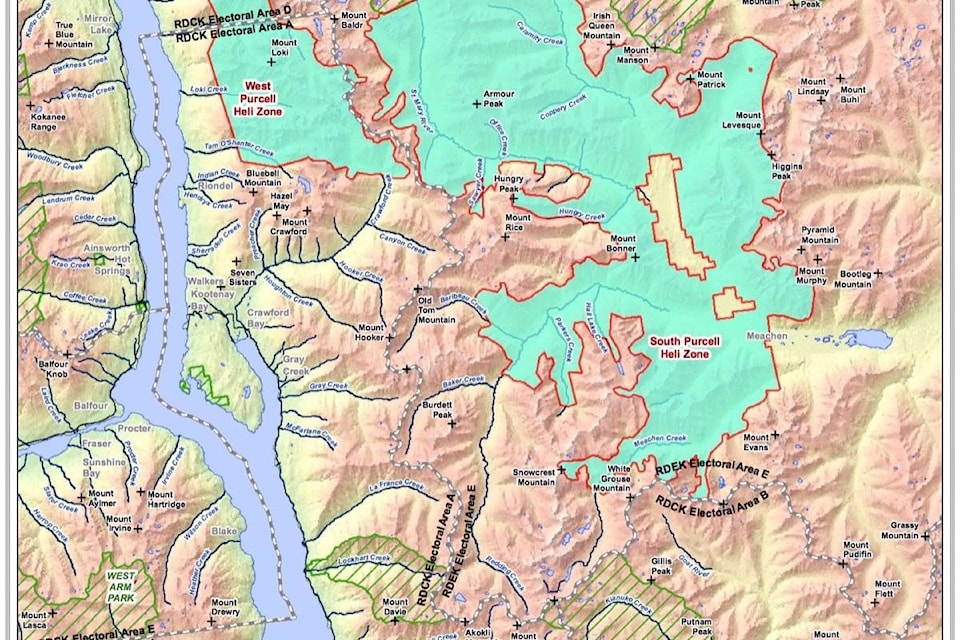Retallack and the Lower Kootenay Band (yaqan nu?kiy) are requesting a Licence of Occupation for a 45-year term in the Purcell Mountains, an operating area of 71,000 hectares, for the purpose of conducting various guided adventure tourism activities on Crown land year-round. The proposed location is on the east side of Kootenay Lake, south of the Purcell Wilderness Conservancy.
The yaqan nu?kiy is one of six bands that make up the Ktunaxa Nation. Historically and since time immemorial, the yaqan nu?kiy were the original inhabitants of the Lower Kootenay area.
Read More: Lower Kootenay Band and Retallack Partner to propose innovative adventure tourism tenure.
Retallack is based in Nelson, BC and provides backcountry catskiing, snowboarding, and mountain biking adventures in the Selkirk Mountains. They also operate an 11,000-square-foot lodge north of Nelson.
The proposed multiple use tenure area consists of two operating zones: the ‘West Purcell Zone’ (11,829 hectares) and the ‘South Purcell Zone’ (59,163 hectares). Both zones will be used in the winter for heliskiing, ski touring, snowshoeing, dogsledding, mountaineering and filming. In the summer, they will be used for mountain biking, helibiking, hiking, helihiking, mountaineering/climbing, horseback riding and filming.
Both zones will be accessed via a combination of air (helicopter) and ground staging areas near Retallak, Ainsworth, Riondel, Kimberley, Crawford Bay, and Gray Creek.
“It is important to note that the operating zones being proposed have been chosen due to their limited public access and use. In addition, none of the proposed areas are within currently restricted caribou habitat,” states the Management Plan.
Kimberley Resident Josh Cormack reached out to the Bulletin, as he is an avid backcountry user who says this proposal could affect many like himself.
“This could interfere with everyone who enjoys the St. Mary’s Valley,” said Cormack. “I’m not opposed to development, and this kind of proposal, however Retallack says that in the future they hope to have ten helicopter trips per day, which will absolutely affect recreational users as well as the ecosystem in that area.”
Retallack says that future plans include the construction of a luxury lodge and spa overlooking Kootenay Lake on lands transferred to the Lower Kootenay Band.
The Management Plan is a very detailed proposal that outlines Retallack and yaqan nu?kiy’s plans including proposed area maps, safety procedures, construction, wildlife population, environmental impacts, First Nations territory, public use and more. For a copy of the plan visit the BC Government website (https://arfd.gov.bc.ca/ApplicationPosting/viewpost.jsp?PostID=54966).
As mentioned, part of the plan covers wildlife population and environmental impacts, including a statement that no legal old growth management areas currently overlap the proposed operating zones.
Eddie Petryshen, Conservation Coordinator for Wildsight says that if the tenure is granted, it could have a huge affect on the wildlife population, wilderness, and quiet recreation value in the Purcells.
“There is documented evidence that this area has high recreational use, along with a large wildlife population of mountain goats, caribou, grizzlies, and wolverines,” said Petryshen. “We have declining wildlife populations across a pretty wide spectrum of species in the south Purcells. Caribou have declined over the last 20 years and 13 to 17 remain in the south Purcells. Wolverines are believed to exist at an extremely low density and show low connectivity with other populations in southeast BC. The latest wolverine research suggests that wolverine presence is negatively associated with forest service road density and human disturbance, and positively associated with protected areas such as provincial parks and low usage wilderness areas.
“Mountain goat numbers are also in decline, the two goat population units in the south Purcells have declined by 44 per cent and 17 per cent each. The bottom line is, we don’t need additional stress, disturbance, and high impact recreation on these already stressed wildlife populations and this ecosystem.”
Petryshen explained that animals such as mountain goats and caribou will initiate a predator response to helicopters, which not only stresses them out but can cause abandoned habitats. He says that flight patterns won’t be able to completely avoid critical caribou habitat, especially during times with challenging weather.
There could also be large implications on the Grizzly population, says Petryshen, and the proposed area “substantially overlaps core, secure Grizzly bear habitat”.
“Huckleberry patches used by Grizzly bears are extremely important; they determine all kinds of success in terms of their survival, including reproduction. This could mean they no longer have secure refuge areas,” said Petryshen. “These are linkage areas for Grizzly bears and they are important. For example, from Duck Lake into the Selkirks is where Grizzlies move and interchange DNA, they keep the gene pool going, and there’s potential to fragment that.”
Another key point, Petryshen says, is that this goes against the Cranbrook West Recreation Management Strategy.
“Commercial aerial use isn’t permitted in those areas; they can’t land there,” Petryshen explained. “This was a public process and agreement. The tenure proposal undermines that public process.”
With regards to the public’s recreational use of those lands, Petryshen says it could affect the value of that wilderness for locals and tourists alike.
“If we’re [eventually] going to see 30,000 annual trips, as proposed, that is constant helicopter traffic. That area is largely used for public recreation and it’s a value that we don’t always think about; most people headed up there are in search of quiet, they are seeking that escape,” Petryshen said. “This could change the way recreational users use that land and where they go.
“I think there’s also an economic implication, we’re kind of the last area that isn’t heavily tenured. I think it’s really valuable to have those places of quiet for recreation, and where wildlife can sustain.”
Wildsight will be hosting a public information session in Kimberley, Gray Creek, and Cranbrook in the coming weeks, with dates and times to be announced.
The BC Government will be accepting comments for the application until May 13, 2018. To comment on the application, visit https://arfd.gov.bc.ca/ApplicationPosting/viewpost.jsp?PostID=54966.
